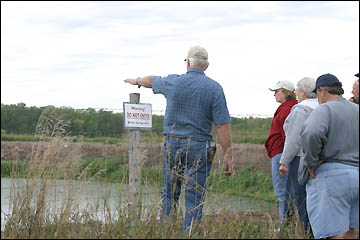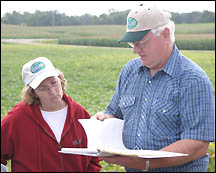Lake association tours farm to learn about ag practices
 That's why Brinkman, the farm manager of Kocka Farms, hosted the Rice Lake Association Board of Directors on a farm tour on Saturday morning.
That's why Brinkman, the farm manager of Kocka Farms, hosted the Rice Lake Association Board of Directors on a farm tour on Saturday morning.
The goal, according to Hanson, president of the Rice Lake Associa-tion, is to learn about agriculture practices and to build bridges between lakeshore owners and the ag community.
The Kocka Farm - owned by the Lloyd Peterson family - is located in the southeast corner of Paynesville Township, a half mile southeast of the Crow River as it flows from Rice Lake to Lake Koronis.
Dave Brinkman, farm manager for Kocka Farms, explains their liquid manure pit and how they inject liquid manure into their fields to board members of the Rice Lake Association. The tour on Saturday was intended to promote better understanding between agriculture and lake residents.
Nearly a decade ago, a concrete feedlot was built on the farm. The feedlot collects all the manure and straw on a concrete slab, then the liquid manure is pumped to a clay-lined pond. Both the solid manure and liquid manure are then spread on the farm fields, according to a nutrient plan and manure management plan.
The concrete feedlot keeps all the nutrients from the beef cows on the farm and it keeps the front field of the farm from flooding, said Brinkman, improving production on that field. And it keeps the farmyard from turning to mud in the spring, making it easier to maneuver farm equipment.
But this is an expensive solution, said Brinkman. And not just its upfront cost of construction.
Knifing the liquid manure into the soil costs money, said Brinkman, especially in a wet summer when the pond fills mostly with rainwater. To pump and spread the liquid manure, knifed into the soil for crops or aerated into the soil for alfalfa, costs $7 per 1,000 gallons, said Brinkman. Its nutrient value is only $1.29 per 1,000 gallons, added Brinkman.
Plus, every time he spreads manure he has to have a sample tested (costing $25), to check its nutrient levels. In addition, soil samples (also costing $25) are taken in the fields each spring to figure manure and fertilizer needs.
The concrete feedlot is really just a septic system for animals, said Hansen on the farm tour.
"That's right," said Brinkman.
Brinkman, who serves on the board of directors for the Stearns County Soil and Water Conservation District, wants farmers to know that there are all kinds of options for environmentally-friendly farm operations. Plus, funding is available for farmers to pursue these projects.
In addition to the concrete feedlot, other conservation measures on the Kocka Farm are calibrating the manure spreader to measure how much manure is actually spread (stopping overmanuring of some fields, especially those nearest to the feedlot); establishing buffer strips around wetlands; and building ten water basins (to temporarily hold water during heavy rains, preventing erosion).
"There are a lot of things you can do to keep manure and fertilizer out of the water," said Brinkman, "but it isn't always cheap."
 Each farmer, he realizes, must choose what works for their operation, and funding is more competitive nowadays, but farmers should explore their options, he feels.
Each farmer, he realizes, must choose what works for their operation, and funding is more competitive nowadays, but farmers should explore their options, he feels.
Environmentally-conscious farming techniques are common sense, according to Brinkman, and just part of being "neighborly."
Dave Brknkman shows some of the paperwork he completes for the farm to Kay Hanson, president of the Rice Lake Association.
Hansen has similar goals for the lake association, whose ultimate goal is to improve water quality in the local rivers and lakes. To do that they need to understand and work with everybody who has impact on surface water. The board's goal is to develop good working relationships with other segments of the community and not to point fingers, said Hansen.
The Stearns County SWCD, noted Brinkman, now funds many landscaping projects on rivers and lakes, where a decade ago it concentrated solely on agriculture.
Education, Brinkman and Hansen agree, is the key to change and to cooperation on environmentally-friendly projects.
Brinkman credits the late Lloyd Peterson, a prominent local farmer and also a former board member on the Koronis Lake Association, for trying to support farming and water quality. So while Brinkman explained to the ten board members the paperwork he has to complete to run the farm - a crop plan, a nutrient plan, a conservation plan for highly erodable land, etc. - he also asked the board members if they fertilize their lawns and if they, like farmers, take soil sample before determining how much fertilizer to use.
Contact the author at editor@paynesvillepress.com • Return to News Menu
Home | Marketplace | Community